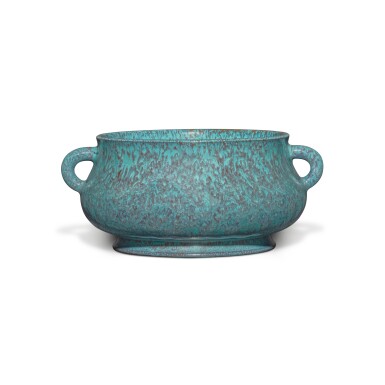Celestial Colors. The Cadle Family Collection of Chinese Monochromes
Celestial Colors. The Cadle Family Collection of Chinese Monochromes

A robin's egg-glazed censer, Seal mark and period of Yongzheng | 清雍正 爐鈞釉雙耳爐 《大清雍正年製》款
Auction Closed
March 21, 02:11 PM GMT
Estimate
400,000 - 600,000 USD
Lot Details
Description
A robin's egg-glazed censer
Seal mark and period of Yongzheng
清雍正 爐鈞釉雙耳爐 《大清雍正年製》款
the base impressed with a six-character seal mark, together with Sotheby's Hong Kong catalogues of the Edward T. Chow Collection, Part One: Ming and Qing Porcelain, 25th November 1980, and Part Three: Ming and Qing Porcelain and Works of Art, 19th May 1981 and a Sotheby's Hong Kong catalogue, 20th-21st May 1987 (4)
及 香港蘇富比仇焱之收藏專場拍賣圖錄,第一場:《Ming and Qing Porcelain》,1980年11月25日、第三場:《Ming and Qing Porcelain and Works of Art》,1981年5月19日及香港蘇富比圖錄,1987年5月20至21日
Width across handles 8¼ in., 20.8 cm
Collection of Edward T. Chow (1910-1980).
Sotheby's Hong Kong, 19th May 1981, lot 502.
Robert Chang, Hong Kong.
Sotheby's Hong Kong, 20th May 1987, lot 516.
J.J. Lally & Co., New York.
仇焱之 (1910-1980) 收藏
香港蘇富比1981年5月19日,編號502
張宗憲,香港
香港蘇富比1987年5月20日,編號516
藍理捷,紐約
'Along with the variegated splashes, [the glaze] cascades down in fluid streaks all varied in length, some straight, some curved, others like the fog amongst the mountains, and the mist amidst the clouds… Likened to the colorful tail of a peacock, immaculate and beautiful'
Geng Baochang, Ming Qing ciqi jianding [Appraisal of Ming and Qing porcelain], Hong Kong, 1993, p. 255.
Geng's expressive commentary on the 'robin's egg' glaze found on vessels made during the Yongzheng period perfectly encapsulates the remarkable quality of this brilliant glaze. Developed at Jingdezhen under the pioneering direction of the official Tang Ying, who is known to have studied in detail the finest imperial porcelains of the Song dynasty, the 'robin's egg' glaze was created as a reinterpretation of the famous Jun glazes of the Song. Known as lujun ('furnace Jun') in China, the glaze was fired at a lower temperature than that of the porcelain itself and required a second firing. In Taocheng jishi [Records of ceramic production], written by Tang Ying in 1735, the last year of the Yongzheng reign, lujun glaze is listed first amongst the nineteen major types of ceramics he had succeeded in firing and proposed as suitable for regular delivery to the imperial court. Although the production of 'robin's egg' glaze continued until the end of the Qing dynasty, the finest pieces were created in the Yongzheng and Qianlong periods.
Similar to his father, the Kangxi Emperor, the Yongzheng Emperor took a keen interest in the work of the various imperial manufactories across his empire and the production of the Jingdezhen imperial kilns in particular; yet unlike his father, the workshop's artistic direction was heavily influenced by his personal taste. From fine-tuning shapes to ideal, harmonious proportions, developing sophisticated yet uncontrived designs, to taking the best works of the past as standards to aspire to, he achieved, together with Tang Ying, a porcelain production of a distinctive style and material refinement unmatched in any other period.
Indeed, the present censer is a testament to the fine potting, exquisite glaze and elegant form that Yongzheng imperial ceramics are known for, all contributing to a refined subtlety that reflects the temperament of the Emperor himself. The thick glaze is evenly applied to the handsome censer and its variegated, mottled design achieves a sense of timeless elegance. The turquoise is further heightened with violet-red streaks, attributing the present censer to a group of highly regarded 'robin's egg' wares believed to represent the best of their type. According to Nanyao biji [Notes of the Southern Kiln], composed during the Qianlong reign, wares with violet-red streaks in the glaze were deemed to be of the best quality, whereas ones with blue streaks were of a lesser standard. Furthermore, Geng likens the color of the violet-red cascades to red millet, stating that this characteristic only persisted until the early years of Qianlong, making it a reliable method for dating wares of this type (see ibid.).
Compare several closely related examples: one included in the Min Chiu Society exhibition Monochrome Ceramics of Ming and Ch'ing Dynasties, Hong Kong Museum of Art, Hong Kong, 1977, cat. no. 108; one in the Zande Lou Collection, illustrated in Qing Imperial Monochromes of the Zande Lou Collection, Hong Kong, 2005, pl. 22; and another, sold in our Hong Kong rooms, 23rd October 2005, lot 305, and again at Christie's Hong Kong, 25th November 2014, lot 2950.
「……各種長短不同的垂流條紋,有的垂直,有的彎曲,還有的似山嵐雲氣……如同五彩繽紛的孔雀尾羽一樣整齊美麗」。
耿寶昌,《明清瓷器鑑定》,香港,1993年,頁 255。
以上是耿寶昌先生對雍正年製爐鈞釉器的評論,他生動的描述讓讀者充分感受到爐鈞釉斑斕奪目的神采。據説,督陶官唐英曾經深入研究宋代御瓷珍品,清朝景德鎮御窰在他監督之下,以宋代鈞窰為靈感研創出爐鈞釉。燒製爐鈞釉溫度需要低於瓷器本身的燒製溫度,而且需要兩度入窰。唐英於雍正朝末年,即1735年所著的《陶成紀事》當中記錄,爐鈞釉是他任內成功燒製十九種官瓷之第一,建議定期呈貢入朝。爐鈞瓷續燒至清代晚期,然而品質最精的珍品都是出自雍正及乾隆二朝。
康熙帝對宮廷御作的出品十分關注,繼任的雍正帝亦秉承康熙對藝文的熱忱,對景德鎮御窰的運作尤其重視。而雍正與其父親康熙不同的地方在於前者的個人品味對御窰藝術風格影響相當明顯。無論器型、比例、紋飾等各方面,雍正都以含蓄優雅的瓷器為尚,而且以古代珍瓷為標準,督陶官唐英按照皇帝心意,發展出獨特的藝術風格,所製瓷器材質上乘,傲視古今。
本品極能展示雍正御瓷胎釉精細、輕巧玲瓏、線條優雅、風格淡雅的特色,而這些特點又與雍正皇帝內斂的性情吻合。香爐造形秀麗,釉料厚重均勻,以斑駁的顔彩營造出歷久彌新的優雅氣質。釉面紫紅色的條紋與綠松石色互相襯托,從此特色可推斷本爐乃出自一組備受推崇的爐鈞器,該組瓷器廣獲讚賞為同類中的佼佼者。據乾隆年間《南窰筆記》敘述,釉中有紫紅色條紋的為上品,有藍色條紋的為次。 此外,耿寶昌先生將紫紅色的垂流條紋比作紅小米,並指出這種特徵在乾隆初年之後再不復見,使其成為此類器物的可靠斷代方法(出處同上)。
參考几件相關近例:其一展於敏求精舍展覽《明清一色釉瓷》,香港藝術館,香港,1977年,編號108;另一例可見於暫得樓珍藏,錄於《暫得樓清代官窰單色釉瓷器》,香港,2005年,圖版22;亦見一例,售於香港蘇富比2005 年 10 月 23 日,編號 305,後來再次易手於香港佳士得2014 年 11 月 25 日,編號 2950。
